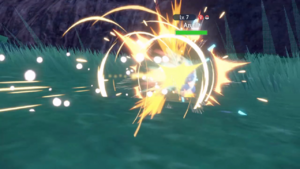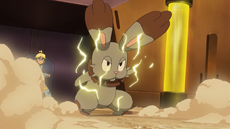Recoil: Difference between revisions
m (→Mechanics) |
|||
| Line 217: | Line 217: | ||
{{Langtable|color={{physical color}}|bordercolor={{physical color light}} | {{Langtable|color={{physical color}}|bordercolor={{physical color light}} | ||
|da=Rekylskade | |da=Rekylskade | ||
|fi= | |fi=Vastavahinko ([[XY067]])<br>Takapotku ([[DP185]]) | ||
|fr=Contrecoup | |fr=Contrecoup | ||
|de=Rückstoß | |de=Rückstoß | ||
Latest revision as of 18:55, 21 March 2024
- This article is about the damage caused by some moves. For the beta name of Magneton, see Magneton (Pokémon).
- Not to be confused with the Recoil status condition in Pokémon Mystery Dungeon.

Recoil (Japanese: 反動 recoil) is the damage taken by the attacking Pokémon when successfully using certain risky moves. In most cases, recoil damage is proportional to the damage dealt to the opponent, but some moves (most notably Struggle) cause the user to take damage proportional to their own HP.
Decription
| Generation I | Generation II | Generation III | Generation IV | Generation V | Generation VI | Generation VII | Generation VII | Generation IX | |
|---|---|---|---|---|---|---|---|---|---|
| SwShBDSP | LA | ||||||||
| "(Enemy) <Pokémon>'s hit with recoil!" | "(Wild/Foe) <Pokémon> is hit with recoil!" | "(The wild/foe's) <Pokémon> was damaged by the recoil!" | "(The wild/opposing) <Pokémon> was damaged by the recoil!" | "(The wild/The opposing/Totem) <Pokémon> was damaged by the recoil!" | "(The wild/opposing) <Pokémon> was damaged by the recoil!" | "<Pokémon> was hurt by the recoil!" | "(The wild/opposing) <Pokémon> was hurt by the recoil!" | ||
Mechanics
Moves that have recoil are damage-dealing moves that cause the user to take damage after being used.
For most recoil moves, the amount of recoil damage is proportional to the damage dealt (the exact proportion varying between moves); however, for Struggle (from Generation IV onward) and Shadow Rush (in Colosseum only), the recoil damage is proportional to the user's maximum HP, while Shadow End has recoil proportional to the user's current HP.
In Pokémon Stadium only, if a recoil move knocks out the opponent, then the user will not take recoil damage.
Several Abilities affect recoil moves. None of them affect Struggle, Shadow RushColo, or Shadow End.
- The Ability Rock Head prevents the Pokémon that has it from taking recoil damage.
- The Ability Reckless increases the power of moves with recoil by 20%, except Struggle. (Due to increasing the damage dealt, this also increases the recoil by the same proportion.)
- The Ability Magic Guard prevents the Pokémon that has it from taking indirect damage (including recoil damage).
Recoil is not considered an additional effect by Sheer Force. Even if a recoil move does have a secondary effect that is suppressed by Sheer Force (such as Flare Blitz), Sheer Force does not prevent the user from taking recoil damage.
Recoil is mandatory to evolve White-striped Basculin into Basculegion, as White-striped Basculin must cumulatively lose 294 HP to recoil damage without fainting to evolve.
Similar mechanics
Some moves have crash damage, a similar concept where the user takes damage only if the move fails to affect its target. Though these moves are also affected by Reckless, this damage is not recoil damage.
The item Life Orb causes its holder to take damage whenever it uses a move, but this damage is not recoil damage. Additionally, unlike recoil damage, this damage can be prevented by Sheer Force (if the move used has an additional effect).
The moves Mind Blown and Steel Beam cause the user to take damage after use, but this damage is not recoil damage. Several other moves deal damage to the user that always causes it to faint when used.
Moves with recoil damage
| Name | Type | Category | Power | Accuracy | Recoil | Notes |
|---|---|---|---|---|---|---|
| Brave Bird | Flying | Physical | 120 | 100% | 1/3 of damage dealt | |
| Chloroblast | Grass | Special | 120 (Gen. VIII) 150 (Gen. IX+) |
95% | 1/2 of user's maximum HP | |
| Double-Edge | Normal | Physical | 100 (Gen. I) 120 (Gen. II+) |
100% | 1/3 of damage dealt (Gen. III+) 1/4 of damage dealt (Gen. I-II) |
|
| Flare Blitz | Fire | Physical | 120 | 100% | 1/3 of damage dealt | 10% chance of burning the target. |
| Head Charge | Normal | Physical | 120 | 100% | 1/4 of damage dealt | |
| Head Smash | Rock | Physical | 150 | 80% | 1/2 of damage dealt | |
| Light of Ruin | Fairy | Special | 140 | 90% | 1/2 of damage dealt | This move is exclusive to a Pokémon that has never been legitimately available. |
| Self-DestructLA | Normal | Physical | 150 | 100% | 4/5 of user's maximum HP | |
| Shadow End | Shadow | Physical | 120 | 60% | 1/2 of user's current HP | |
| Shadow RushColo | Shadow | Physical | 90 | 100% | 1/16 of user's maximum HP | 95% chance to land a critical hit when the Pokémon is in Hyper Mode |
| Struggle | Normal | Physical | 50 | 100% (Gen. I-III) —% (Gen. IV+) |
1/4 of user's maximum HP (Gen. IV+) 1/4 of damage dealt (Gen. II-III) 1/2 of damage dealt (Gen. I) |
Hits Ghost-type Pokémon in Pokémon Stadium and from Generation II onward |
| Submission | Fighting | Physical | 80 | 80% | 1/4 of damage dealt | |
| Take Down | Normal | Physical | 90 | 85% | 1/4 of damage dealt | |
| Volt Tackle | Electric | Physical | 120 | 100% | 1/3 of damage dealt | 10% chance of paralyzing the target |
| Wave Crash | Water | Physical | 75 (Gen. VIII) 120 (Gen. IX+) |
100% | 1/3 of damage dealt | Also raises the user's action speed in Legends: Arceus |
| Wild Charge | Electric | Physical | 90 | 100% | 1/4 of damage dealt | |
| Wood Hammer | Grass | Physical | 120 | 100% | 1/3 of damage dealt |
In the anime
Recoil has been noted multiple times in the anime, most notably after Pikachu uses Volt Tackle. Brock has stated many times that Volt Tackle causes recoil and is very risky.
Ash's Staraptor and Reggie's Staraptor both know Brave Bird, which was stated to do recoil damage, making it a very risky move. The same goes for Flint's Infernape and Ash's Infernape, who both know Flare Blitz, and Roark's Rampardos, who knows Head Smash.
Take Down is referred to as a risky move numerous times in the anime, along with Double-Edge. However, in some early anime episodes, such as The Battle of the Badge, where Ash's Pidgeotto used Double-Edge, it apparently took no recoil damage.
In The Moment of Lumiose Truth!, Clemont's Bunnelby was revealed to have learned Wild Charge. However, immediately after using Wild Charge, Bunnelby used Dig to cut down on the effects of recoil damage.
In the TCG
The Pokémon Trading Card Game does not officially recognize recoil damage. Regardless, certain attacks cause a Pokémon to inflict damage "to itself", and damage dealt to itself is distinguished from damage dealt to opponents. (The card Protection Cube protects a Pokémon from damage inflicted by its own attacks.) Some common variations on attacks that inflict damage to their users are attacks that only do so if a coin flip has a "Tails" result, and attacks that only cause self damage if the player chooses to deal more damage to the Defending Pokémon.
Attacks named after attacks from the core series that cause recoil damage, such as Take Down and Double-Edge, often cause the Pokémon to deal damage to itself. The moves Self-Destruct and Explosion, which cause the user to faint in the games, usually only cause self damage equal to the card's maximum HP in the Trading Card Game. This means that HP increasing effects or damage reducing effects can allow a Pokémon to survive dealing damage to itself that is intended to cause it to be Knocked Out. (Some effects, such as Minior's Cosmicsplosion, do specifically Knock Out the user.)
In other languages
| |||||||||||||||||||||||||||||||||||||||||||
See also

|
This game mechanic article is part of Project Games, a Bulbapedia project that aims to write comprehensive articles on the Pokémon games. |
